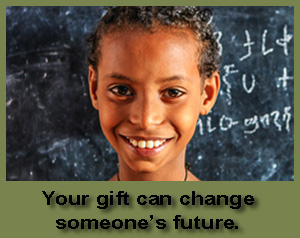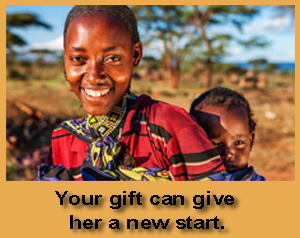Ethiopia is the oldest independent country in Africa, one of the oldest countries in the world (over 2,000 years), and the second-most populous country in sub-Saharan Africa. The three colors of its flag, adopted in the late 1800’s, have been copied so much by other countries that they have become known as the Pan-African colors. The coffee bean originated in Ethiopia. With its rich soil, Ethiopia continues to be the top coffee producing country in Africa. The country’s diverse terrain includes breathtaking waterfalls, some of the highest mountains in Africa (4,500 meters), and one of the hottest places on earth (Dallol).[3,11] It also has the distinction of having the most UNESCO World Heritage Sites in Africa.[3]
The country is 1.1 million sq. km. (about twice the size of Texas, or the size of France and Spain combined), with a population of 91 million people[1] and a life expectancy of 57.[4] Nearly half of the population is under the age of 14, and less than 3% are over the age of 65.[1] Although there are about 80 total ethnic groups in Ethiopia, 85% of the population is divided between 7 ethnic groups.[1] 61% of Ethiopians are Christian, and 33% are Muslim.[1]
Economics
The per-capita Gross National Income is $280/year.[13] The minimum wage is 8 birr/day (USD 60 cents).[10] Nearly 40% of the population is below the poverty line, living on less than $1.25/day.[2] Agriculture accounts for 45% of the GDP[13] and 85% of employment.[1]
Civil war and political conditions have contributed to the economic conditions. Unique among African countries, the ancient Ethiopian monarchy maintained its freedom from colonial rule with the exception of a short-lived Italian occupation from 1936-41. In 1974, a military junta, the Derg, deposed Emperor Haile Selassie (who had ruled since 1930) and established a socialist state. Torn by bloody coups, uprisings, wide-scale drought, and massive refugee problems, the regime was finally toppled in 1991 by a coalition of rebel forces, the Ethiopian People’s Revolutionary Democratic Front. A constitution was adopted in 1994, and Ethiopia’s first multiparty elections were held in 1995.[3]
Despite the regime change, the state continues to own all of the land[9,10]: citizens may lease land, but may not sell or transfer it. State ownership of land is the primary impediment to larger, more efficient farming operations, and the main cause of poor cultivation practices and low productivity.
Poverty is compounded as the cycle continues: because families only lease a small amount of land, they cannot afford to do anything but farm it to its maximum capacity, without a break (lying fallow or crop rotation). Overfarming causes soil degradation, which reduces the production of fodder for livestock, which causes low milk yields and declining livestock populations, which leads to less fertilizer available for farming (manure is also burned as fuel), which contributes to lower crop production, which increases poverty, which leads to additional hunger, malnutrition, and disease, all of which further challenge individuals’ physical ability to farm, and pressures continuing overuse of the land.[3,9]
The absence of private property also stifles growth in non-ag (e.g. industry) sectors. The government has a monopoly on the telephone system, which remains substandard. There are fewer than 1 million landline phones and 3 million cell phones, which amounts to less than 1 phone for every 20 people.[1]
Health
94% of births do not have a skilled attendant present; 4% of women will die in childbirth.[2] Although the infant mortality rate has improved over the past five years, it is still nearly 7%.[2] Of the children who survive birth, another 4% will die before their 5th birthday.[2] (The overall mortality rate 0(birth) – 5 years old is 11%.[2,4]) Over 60% of the population do not have access to safe drinking water[4,11,13], and 90% do not have access to adequate sanitation facilities.[4] 2% of the population is infected with HIV.[4] The doctor/population ratio is 1:42,000.[8,12]
Children
Child (5 – 14 years) labor is over 50%, as is child marriage.[2] 40% of children under 5 are moderately to severely underweight, and 50% are moderately to severely stunted.[2] Only 45% of children attend primary school,[2] and nearly 60% of the population is illiterate.[1] The primary reason children do not attend school in rural areas is the children are needed for farmwork (48% boys, 16% girls) and housework (53% girls, 16% boys).[17]
Orphans in Africa
UNICEF studies and related literature now use the term “orphan” to describe both “half orphans” (children who have lost one parent) and “double orphans” (children who have lost both parents). This can be somewhat misleading, as most people think of “orphans” as children who do not have a parent to care for them — by UNICEF’s definition, you were an orphan when you lost your father at a young age, but your mother certainly did not see you as such! By this broad definition, over 50 million children in sub-Saharan Africa are “orphans”.[15] This includes 7 million total orphans under the age of 5, and 1 million double orphans under the age of 5.[15] 90% of double orphans and single orphans who do not live with their surviving parent live with extended family (often siblings or grandparents).[15] Children under the age of 5 are the most vulnerable. For example, children 0-3 are four times more likely to die within a year (before/after) of their mother’s death.[15]
Orphans in Ethiopia
There are 5 million orphans in Ethiopia[2,14], 18% of whom have lost at least one parent to AIDs. 34% of orphans have lost their mother, 52% have lost their father, and 14% (700,000) have lost both parents.[15] Of the more than 13 million children in Ethiopia who are under age 52, 4% (over 500,000) have lost at least one parent.[15]
80% of paternal orphans live with their surviving mother, and 68% of maternal orphans live with their surviving father.[15] Orphans are significantly less likely to attend school than non-orphans, are significantly more likely to suffer abuse and exploitation, and are significantly more likely to “think that [their] life will be bad.”[15] 75% of children 10-14 who have lost both parents do not attend school.[15]
Abandonment
Child abandonment is “disturbingly common” throughout Africa.[18] While the reasons for abandonment vary, a large number are by unwed, often young, mothers. In Ethiopia, premarital pregnancies (sometimes the product of rape[18]) are not uncommon, yet children born out of wedlock are often rejected by their families and denied by their fathers. These children are considered “excess” – unwanted and unvalued – and are treated as inferior to legitimate children, receiving less food, less education, and more work.[17]
Orphanages
There don’t seem to exist reliable statistics on Ethiopian orphanages. “There is much that remains unknown about the number of children in residential care in sub-Saharan Africa because estimates are available for only a limited number of countries.”[15] Extrapolating from the orphan statistics that are available, however, we estimate that there are well over 10,000 children in Ethiopia under the age of 5 who are likely living in orphanages (or who would be but for international adoption):
If there are 500,000 orphans under 5, of which over 325,000 live with a surviving parent (34% are maternal orphans, of which 68% live with surviving father; 52% are paternal orphans, of which 80% live with surviving mother, and 14% are double orphans), there are 175,000 orphans who do not live with a parent. If 90% of these orphans are cared for by extended family (consistent with sub-Saharan Africa statistics), there are 17,500 orphans whose living situations are unaccounted for. Even if 40% (?) of these orphans are cared for by non-relatives, at least 10,000 orphans under 5 are still unaccounted for and may be living in orphanages. This figure does not include the thousands of abandoned children living in orphanages. These numbers increase daily, as children continue to be orphaned and abandoned.
There also don’t seem to be statistics available related to the long-term success of children who live for extended periods of time in orphanages in Ethiopia. Some information is available for Russia, however. Like Ethiopia, Russian orphanages “release” children by the time they are 16. With no family support or other resources, 40 percent become homeless, 20 percent become criminals and 10 percent commit suicide.[16]
[1] Central Intelligence Agency – The World Factbook, https://www.cia.gov/library/publications/the-world-factbook/geos/et.html
[2] UNICEF, http://www.unicef.org/infobycountry/ethiopia.html
[3] Wikipedia.org citing various sources, http://en.wikipedia.org/wiki/Ethiopia
[4] World Health Organization, http://www.who.int/countries/eth/eth/en/ ; http://www.who.int/gho/countries/eth.pdf
[5] U.S. Department of State Office of Children’s Issues, http://adoption.state.gov/news/total_chart.html
[6] National Survey of Children’s Health, http://aspe.hhs.gov, http://aspe.hhs.gov/hsp/09/nsap/chartbook/doc/intro-p.1-8.pdf
[7] Based on resources cited by the Child Welfare Information Gateway, http://www.childwelfare.gov/pubs/s_adoptedhighlights.cfm; http://www.childwelfare.gov/pubs/s_place.cfm
[8] World Health Organization http://www.who.int/workforcealliance/knowledge/case_studies/Ethiopia.pdf
[9] See e.g. http://www.ideels.uni-bremen.de/land.html; http://www.wikipedia.org/, http://en.wikipedia.org/wiki/Ethiopia
[10] The Guardian, http://www.guardian.co.uk/world/2010/jan/15/ethiopia-sells-land-farming-giants
[11] World Vision, http://www.worldvision.org/content.nsf/learn/world-vision-ethiopia
[12] The Global Fund, http://portfolio.theglobalfund.org/Country/Index/ETH?lang=en
[13] The World Bank Group, http://ddp-ext.worldbank.org/ext/ddpreports/ViewSharedReport?&CF=&REPORT_ID=9147&REQUEST_TYPE=VIEWADVANCED
[14] UNICEF, Children on the Brink 2004: A Joint Report on New Orphan
Estimates and A Framework for Action, Appendix 1, http://www.unicef.org/media/files/cob_layout6-013.pdf
[15] UNICEF, Africa’s Orphaned and Vulnerable Generations, www.unicef.org/adolescence/files/Africas_Orphaned_and_Vulnerable_Generations_Children_Affected_by_AIDS.pdf
[16] New York Times, A Summer of Hope for Russian Orphans, http://www.nytimes.com/2002/07/21/nyregion/a-summer-of-hope-for-russian-orphans.html?pagewanted=all
[17] Africa Region Human Development Working Paper Series, Issues in Child Labor in Africa, citing various sources, http://www.childtrafficking.com/Docs/andvig_canadaraja_kielland_.pdf
[18] Los Angeles Times, Kenya widow opens arms to abandoned child, December 2009, http://articles.latimes.com/2009/dec/25/world/la-fg-mother-child25-2009dec25
Information compiled by: With Loving Arms, http://withlovingarms.blogspot.com/search/label/A.1.%20Statistics
Last updated: October 2013

